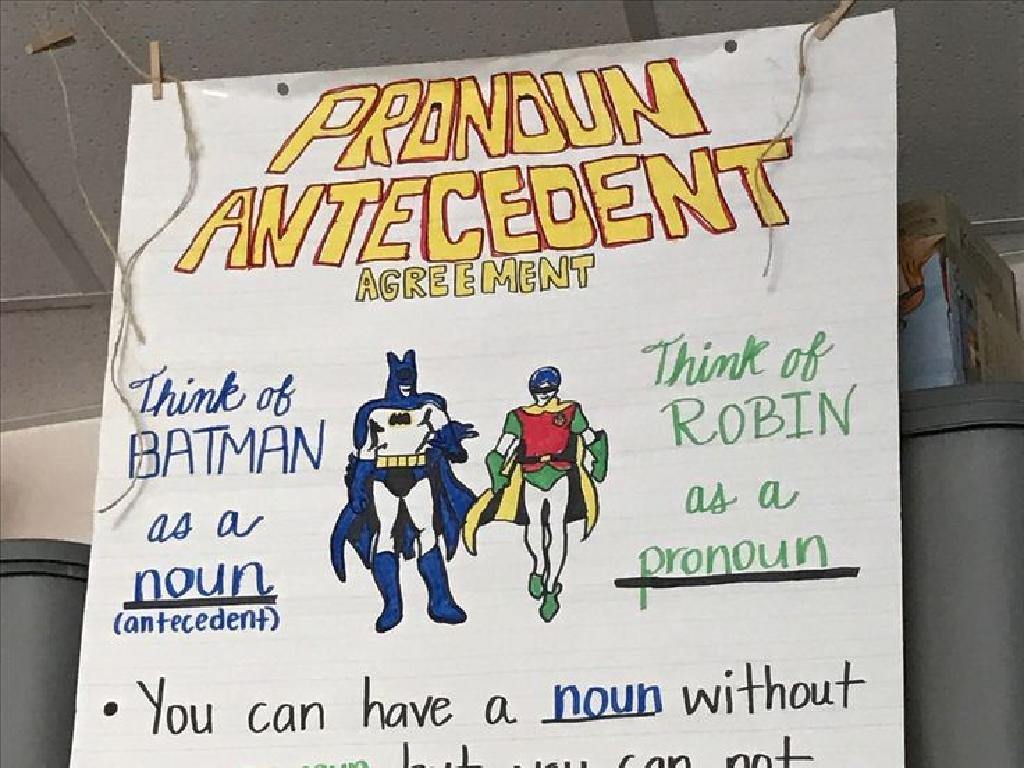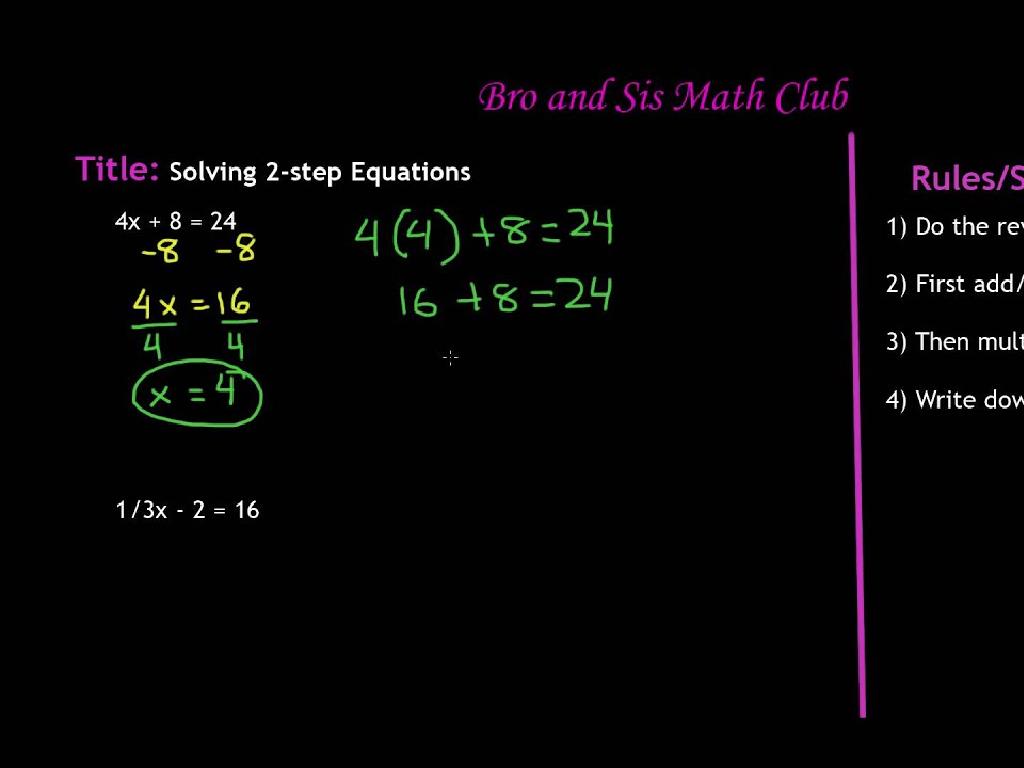Spell Consonant-L-E Words
Subject: Language arts
Grade: Third grade
Topic: Multisyllabic Words
Please LOG IN to download the presentation. Access is available to registered users only.
View More Content
Today’s Adventure: Spelling with Consonant-l-e!
– What are multisyllabic words?
Words with more than one syllable like ‘apple’ and ‘candle’
– Consonant-l-e patterns
Words ending with a consonant followed by ‘le’ like ‘table’
– Importance of big words
Big words make our writing rich and precise
– Practice spelling together
|
This slide introduces third graders to the concept of multisyllabic words, focusing on the consonant-l-e pattern. Start by explaining that multisyllabic words have more than one syllable, which are like beats in music. Emphasize the consonant-l-e pattern by providing examples and showing how the ‘le’ at the end of the word follows a consonant. Discuss why learning big words is important: it helps students express themselves better and understand more complex texts. Engage the class in a fun spelling activity where they practice spelling multisyllabic words with the consonant-l-e pattern. Encourage them to think of more words that fit the pattern and use them in sentences.
Breaking Down Big Words: Consonant-l-e Syllables
– Understanding syllables
– Syllables are parts of a word, each with a vowel sound.
– Practice clapping out syllables
– Let’s clap to find syllables in words like ‘computer’ and ‘banana’.
– Discover consonant-l-e syllable
– A special ending in words like ‘candle’ and ‘bubble’.
– Examples with consonant-l-e
– Words like ‘purple’, ‘castle’, and ‘turtle’ have this syllable.
|
This slide introduces the concept of syllables as building blocks of words, which is fundamental for understanding multisyllabic words. Start by explaining what syllables are and how they make up words. Engage the class by clapping out syllables in words they already know to solidify the concept. Introduce the consonant-l-e syllable pattern, which is common in English and appears at the end of many words. Provide examples and have students practice identifying this syllable type in words. Encourage them to look for this pattern in their reading and use it to help them spell new words. The activity will help students become more comfortable with longer words and improve their spelling skills.
The Magic of Consonant-l-e
– Understanding consonant-l-e
– It’s a pattern where ‘l’ follows a consonant and ends with ‘e’
– Examples: ‘candle’, ‘jungle’, ‘purple’
– ‘candle’ ends with ‘dle’, ‘jungle’ with ‘gle’, ‘purple’ with ‘ple’
– The role of silent ‘e’
– The ‘e’ doesn’t make a sound, but it changes the word
– Practice spelling consonant-l-e words
– Try spelling ‘bubble’, ‘apple’, ‘little’
|
This slide introduces the concept of consonant-l-e word endings, which is a common pattern in English spelling. The ‘l’ follows a consonant and is followed by a silent ‘e’, which often changes the pronunciation of the word. Provide examples like ‘candle’, ‘jungle’, and ‘purple’ to illustrate the pattern. Emphasize that the ‘e’ at the end is silent but important for the correct spelling. Encourage students to practice by identifying more words with this pattern and by trying to spell them on their own. This will help reinforce their understanding of multisyllabic words and improve their spelling skills.
Spelling Patterns: Consonant-l-e Words
– Recognize the consonant-l-e pattern
– Look for words ending with a consonant, ‘l’, and ‘e’
– Practice with example words
– Words like ‘table’, ‘circle’, ‘little’ follow this pattern
– Group words by their endings
– Sort words into groups based on the consonant-l-e ending
– Understand the role of ‘e’
– The ‘e’ is silent, making the ‘l’ sound soft
|
This slide introduces students to the consonant-l-e spelling pattern, which is common in many English words. Start by explaining the pattern and showing how it appears at the end of words. Use example words to help students recognize and become familiar with the pattern. Have students practice spelling by grouping words with similar endings. Emphasize the silent ‘e’ and its role in the pronunciation of these words. For homework, students can create their own list of consonant-l-e words to enhance their understanding and recognition of this spelling pattern.
Let’s Practice Spelling Consonant-l-e Words!
– Interactive group spelling
– Choral repetition practice
– Say words as a class, focus on the ‘l-e’ ending
– Write words with teacher’s help
– I’ll write, we spell it together: ‘candle’, ‘apple’, ‘bottle’
– Review and reinforce learning
|
This slide is for an interactive class activity focused on spelling words with the consonant-l-e pattern. Start with a group activity where the class spells words out loud together, promoting engagement. Follow with choral repetition, where the class repeats words after you, emphasizing the ‘l-e’ sound. Then, write words on the board, guiding students through the spelling of each word. Encourage them to recognize the pattern and apply it to new words. End the activity with a quick review to reinforce what they’ve learned. Possible activities: 1) Spelling bee with consonant-l-e words, 2) Pair students to practice spelling, 3) Use flashcards with consonant-l-e words, 4) Create a word wall with students’ words, 5) Have students write sentences using the words.
Fun with Consonant-l-e Words
– Create your own consonant-l-e words
– Think of words ending with ‘ble’, ‘cle’, ‘dle’, etc.
– Engage in a word search challenge
– Find consonant-l-e words hidden in a puzzle with friends
– Draw pictures for your words
– Illustrate the words you’ve found or created
– Share your creations with the class
|
This slide is designed to make learning about consonant-l-e words interactive and enjoyable. Students will apply their understanding of these words by creating their own, which reinforces spelling patterns and phonetic awareness. The word search is a fun activity that promotes teamwork and attention to detail. Drawing pictures associated with the words enhances memory retention and allows for creative expression. Finally, sharing their work with the class fosters public speaking skills and peer learning. For the teacher: Prepare a word search puzzle in advance and provide drawing materials. Encourage students to use their imagination and think of unique consonant-l-e words.
Class Activity: Building Words with Consonant-l-e
– Build words using consonant-l-e blocks
– Work in pairs to discover new words
– Write down the words you find
– Example: table, little, purple
– Share your words with the class
|
This activity is designed to help students understand and practice spelling multisyllabic words that end with the consonant-l-e pattern. Students will work in pairs to enhance collaborative learning and communication skills. Provide students with blocks or cards that have consonant-l-e endings and various beginning sounds or blends. Encourage them to manipulate these blocks to form new words. After they have written down their words, ask them to share with the class to reinforce their learning and to celebrate their discoveries. Possible variations of the activity could include a timed challenge, creating the longest word, or categorizing the words by the number of syllables.
Consonant-l-e Words: Recap & Homework
– Review of consonant-l-e words
– Practice makes perfect
– Homework: Craft a story
– Use your imagination to write a creative story
– Include 5 consonant-l-e words
– Words like ‘candle’, ‘juggle’, or ‘purple’ can be used
|
As we conclude today’s lesson on consonant-l-e words, remember that these are words that end with a consonant followed by ‘le’. Examples include ‘table’, ‘little’, and ‘circle’. Emphasize the importance of practice in mastering the spelling of these multisyllabic words. For homework, students are tasked with writing a short story that includes at least 5 consonant-l-e words. This activity will help reinforce their understanding and give them a chance to apply what they’ve learned in a creative way. Encourage them to share their stories in the next class for added fun and learning through peer interaction.






